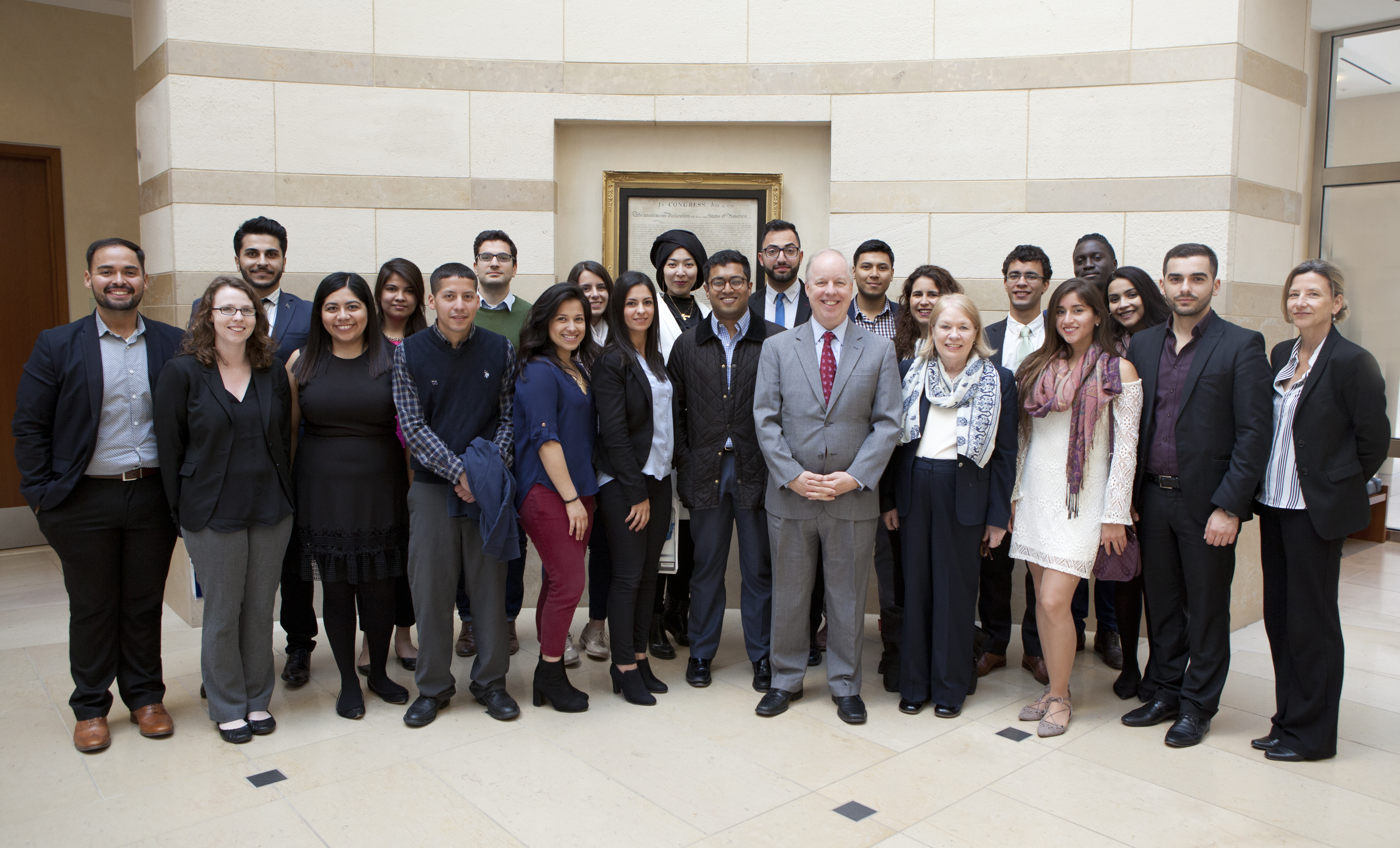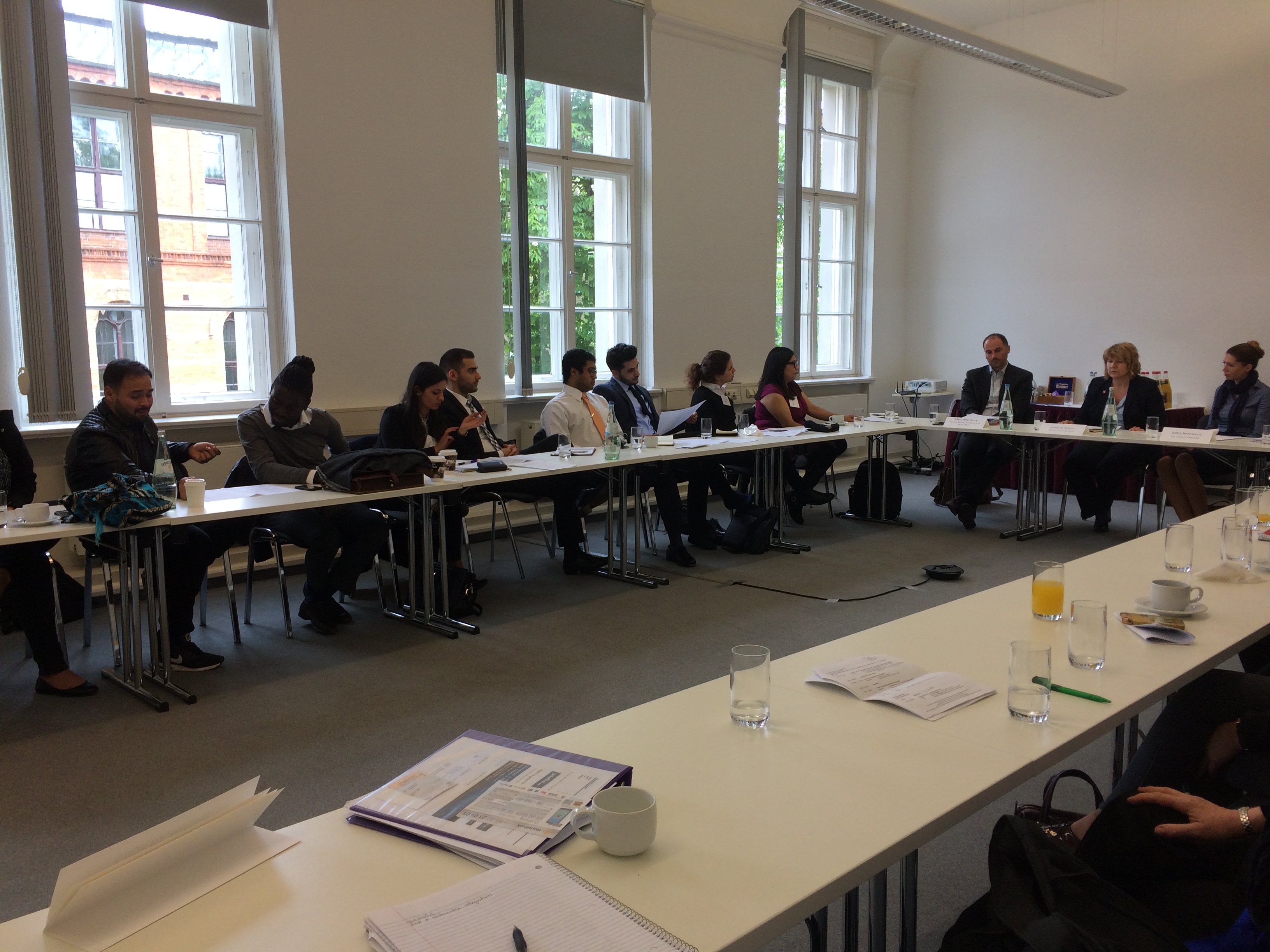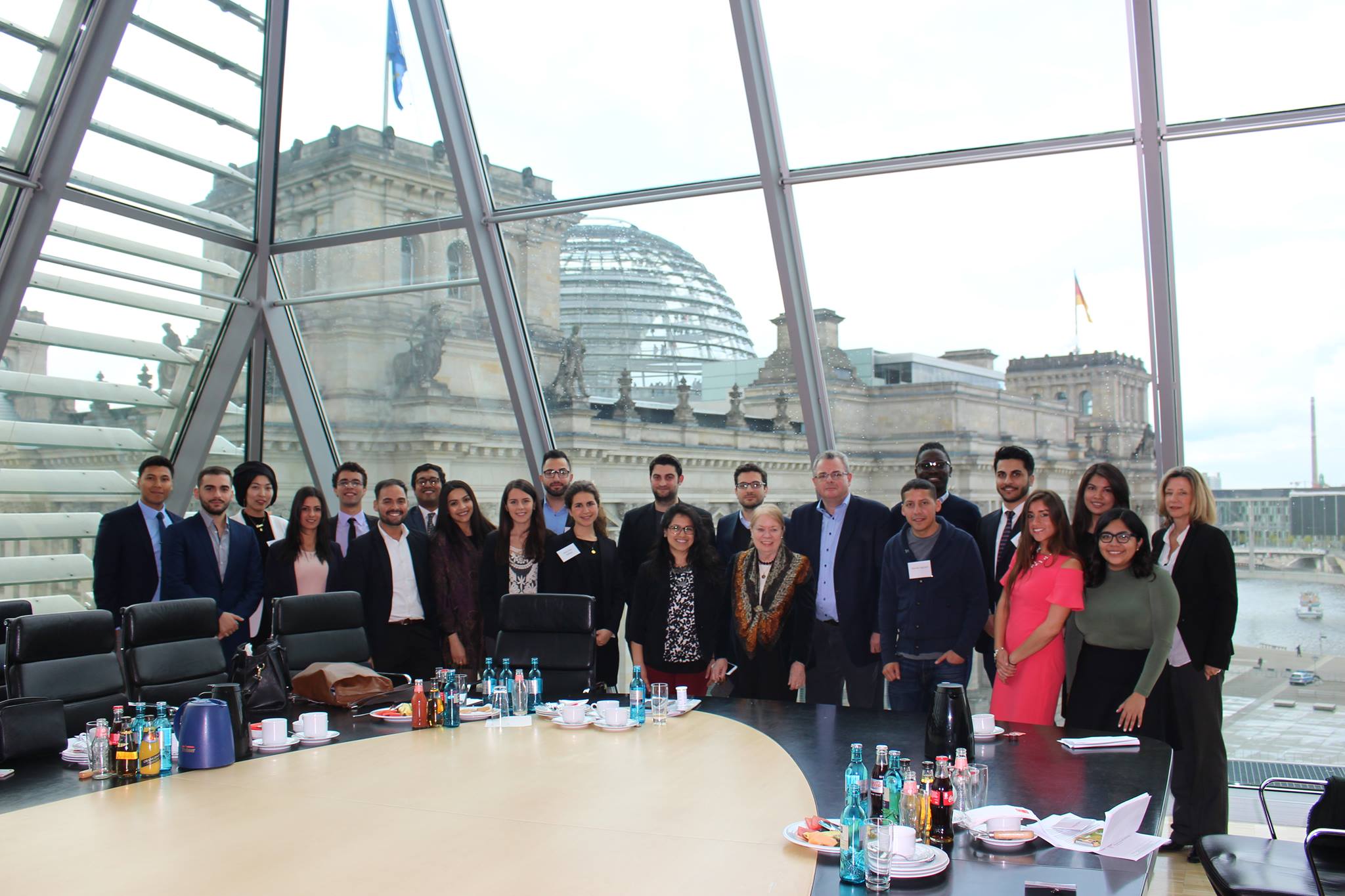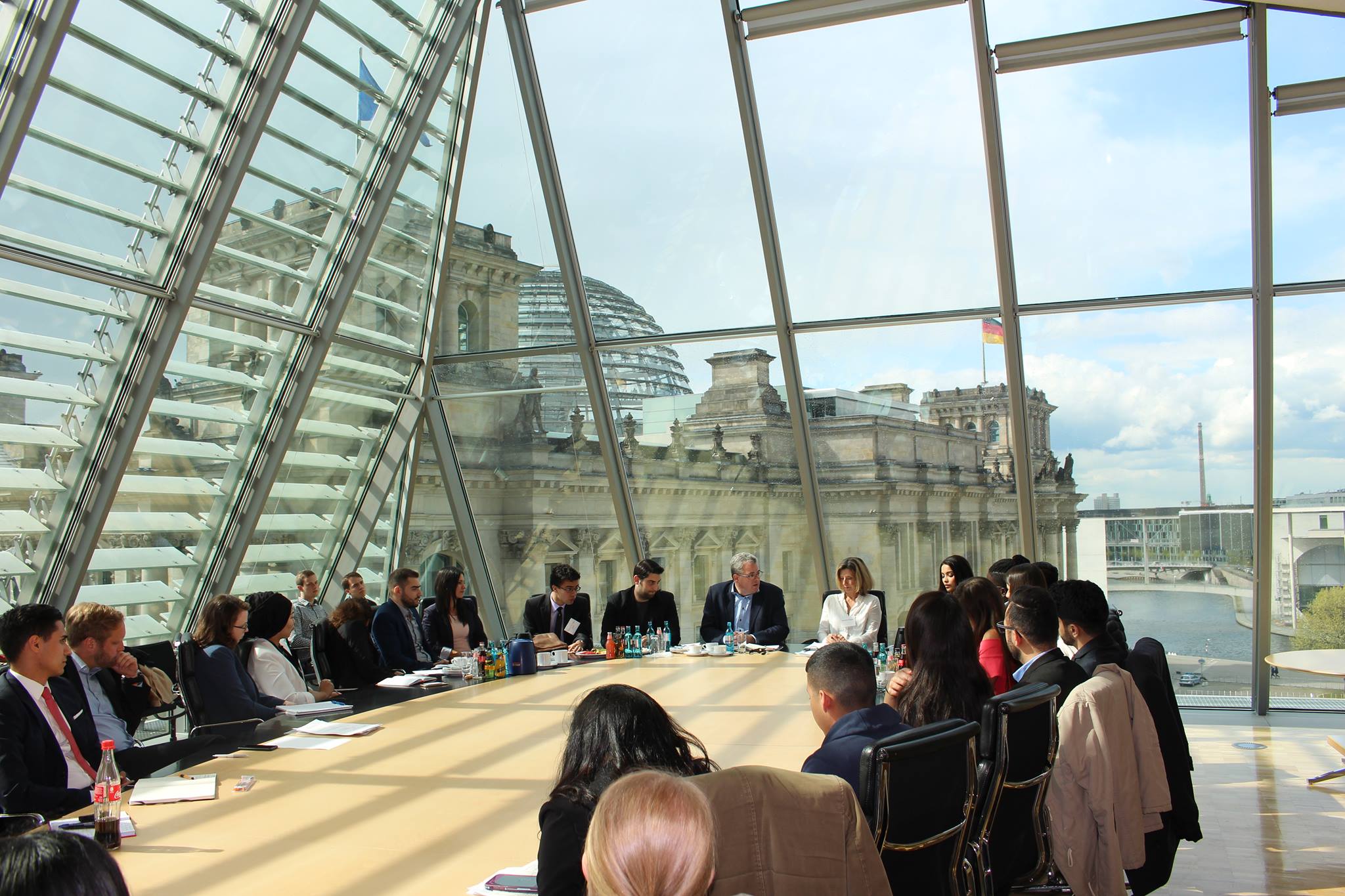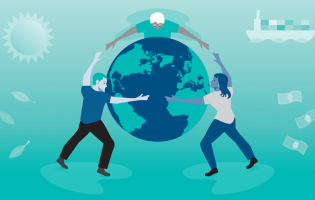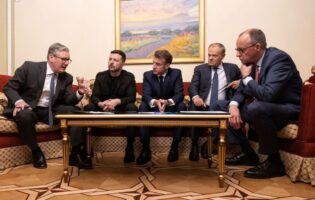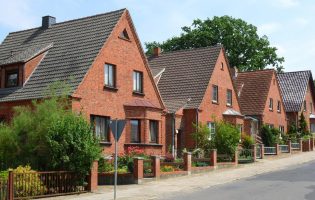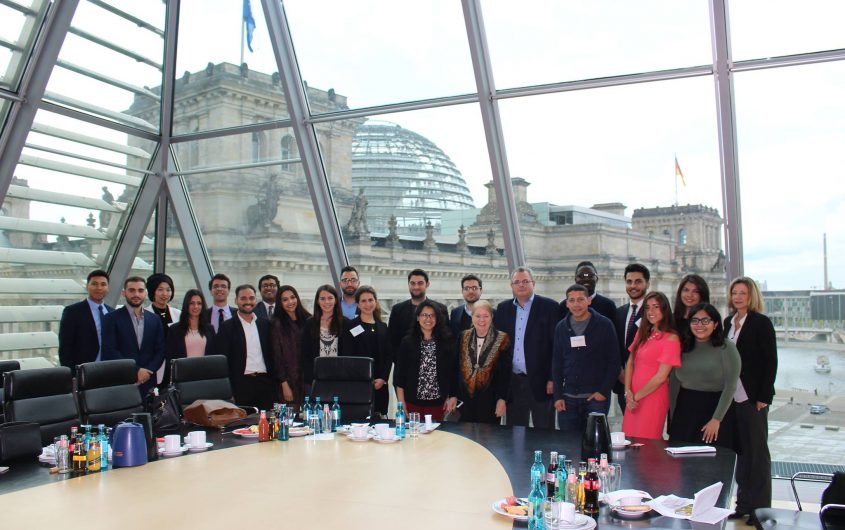
AICGS
Immigration, Integration, and a New Transatlantic Generation
Participants at the seminar engaged in small groups and interact with leading experts from umbrella organizations dealing with immigration and integration, government, research institutions, and political foundations. They also had the opportunity to visit other institutions, including cultural/historical sites, offices of elected representatives, and non-profit associations that focus on issues of the underrepresented.
Panel 1: Political Institutions and Immigration
Speaker: Michael Knoll, Director Hertie Foundation
The Hertie Foundation supports projects in three areas: neuroscience, European integration, and democracy training. The discussion centered primarily on the Hertie Foundation’s work in social innovation and education to promote European integration and democracy training. Particularly, the Hertie School of Governance and Innovation Center for Advanced Practitioners.
The Hertie School of Governance was founded based on the need for a new concept of governance for Germany and a way to train the next generation of leaders in the context of the new European Union administration. The school is the first professional public policy school in Germany, but the idea of a private foundation funding a private school was not new to Germany – they had the example of Bucerius Law School in Hamburg.
The Hertie Foundation wanted to provide a space for young people to try projects and built them up. At the time of the Innovation Center for Advanced Practitioners’ founding, there was no place for academics to come together and discuss and try projects. The idea was to create a space for innovation and collaboration, with the Hertie name being a facilitator and way for their fellows to make the contacts they needed for their work to be successful. Two examples of innovation center projects:
- A kitchen “on the run,” where a contain kitchen traveled through Europe on the path of refugees, connecting people living in towns on the refugee pathways and the refugees themselves, creating first contact between populations and refugees.
- A project reconciling the needs of refugees and the logic of administrations, which led to a paper with proposals for modernization of administration which gave officials a clear view of needs of refugees.
The innovation center currently funds five new projects each year, with a six month project overlap period, in order to connect more people and projects.
Panel 2: Immigration and Politics
Speakers: Mekonnen Mesghena, Department Head Migration and Diversity, Heinrich Böll Foundation; Christina Krause, Coordinator for Refugees and Migration, Konrad Adenauer Foundation; Dietmar Molthagen, Forum Berlin, Friedrich Ebert Foundation; Annette Siemes, Friedrich Naumann Foundation
The presentations and discussions during the third panel touched on the role of the political foundations regarding immigration and integration. The foundations share many goals and their work includes several important elements:
- To provide civic education to the citizens of Germany;
- To inspire young people to engage in politics;
- Activity within Germany as well as in foreign countries across the globe;
- To advance the rights of minorities in Germany;
- To focus on democratic and constitutional structures;
The foundations have different priorities and views regarding immigration in Germany. Controlled immigration, dual citizenship and naturalization as well as integration (not assimilation) are viewed differently in alignment with party politics. All foundations are actively conducting projects and publish papers on a variety of issues, including integration. Discussions about the project of the European Union currently inform the work of the foundations and the goal is to inform the public on refugees, migration and integration, which remain important issue for the German public.
The discussion included the topic of social mobility as well as political representation of minorities in Germany. Studies suggest that minorities are underrepresented in government, media, and other institutions. Efforts are underway in Germany to overcome this discrepancy. The participants recognized the similarity of these issues in the United States. Underrepresentation is a dominant issue in the U.S. discourse.
The refugee situation is still very high on the agenda in Germany. In addition to receiving refugees from the Middle East and Africa, Germany is also a major receiving country of migrants from within the EU who are looking for work. Germany still struggles with what kind of politics is needed to accept and welcome newcomers who bring different skill sets and cultures.
An important aspect of the work of the political foundations is to provide scholarships to underrepresented groups, including gender and social class. Efforts to encourage students who come from non-academic backgrounds are also underway. The alumni of these scholarships act as ambassadors for these programs. However, it is a challenge to promote these opportunities, many people are not aware that they exist. In addition, many high schools are not always open to allowing political foundations to present their work and programs. Many of the German participants commented on how scholarship opportunities helped and encouraged them to pursue a university degree and how important these types of programs are and continue to be for people with an immigration background.
The unique structure of the political foundations in Germany is unparalleled. They do not exist in other European countries or the United States. It is important to note that the foundations promote democracy, dialogue, and consensus within Germany and internationally without promoting their political parties. They constitute an important global quasi civil society actor for the promotion of diplomacy and for raising awareness of important issues.
First Site Visit: German Bundestag
Speakers: Andreas Nick, Member of Parliament (CDU); Teyfik Karakücükoglu, Research Assistant to Manuel Sarrazin (Greens)
The discussion focused on Germany’s history of immigration and integration, and how that differs from the public and political narrative. Germany should acknowledge its status as an immigration country. In the middle of Europe, the German territories were home to migrants for centuries, and today, Germany consistently ranks in the top five of the most popular countries for immigration. However, Germany did not offer institutional integration to guest workers coming to Germany in the 1950s and 60s. Germany did not even consider integration measures until much later, in most cases after “guest workers,” who turned out to not be “guests” at all, began to put down roots and have children.
From citizenship debates in the early 2000s, Leitkultur or “leading culture” debates, to laws regarding the current refugee situation, Germany has often dealt with its immigration policy from one crisis to another, rather than focusing on fundamental structural change. The speakers found the concept of Leitkultur to be ridiculous, especially if one single person or homogenous group is the one deciding what the “leading culture” is. Germany has learned from the failed immigration policies of the 1960s, however, is still struggling with the concept of integration. The discussion about “Leitkultur” that has been on the agenda in the wake of an influx of refugees into the country exemplifies this. Many argue that integration should be based on the constitution only. A debate about ethnic background is counterproductive. In addition to adhering to the German basic law, the creation of opportunities for everybody in Germany, regardless of background, is important.
Panel 3: The Challenges and Opportunities in Immigration and Integration
Speakers: Ulrich Weinbrenner, Head of the Department for Integration, Federal Ministry of the Interior; Luisa Seiler, SINGA Deutschland
In light of the recent refugee crisis, the Department for Integration at the interior ministry has been adapted in order to streamline federal resources and funding. Regarding resources for integration, the federal government can provide funding and programs for language courses and labor market integration. State and local levels of government administration provide schooling, and the local level provides housing support. There is also a federal department for social cohesion and integration, which provides programs and courses for political education, seeks to build relationships between religious communities in Germany, and looks for solutions to Germany’s aging society. The department is trying to be forward-looking and anticipate future migration patterns to Germany, so they can be more prepared and provide better services.
SINGA is a Europe-based organization with programs in six countries. SINGA was founded to connect locals and newcomers on a personal level in communities. SINGA’s main activity is the “living room,” where volunteers host locals and newcomers in their home for an activity such as a meal, storytelling, or watching a movie. SINGA aims to connect people on a personal level with a low threshold for entry; a familiar activity that they can share with someone who they perceive as different. SINGA has also begun to develop professional programs, where locals and newcomers of the same occupation come together and provide information, networks, and expertise to how each system works. The low threshold, person-to-person model is replicable for other organizations trying to connect groups in society that would not normally interact, and other programs have already reached out to SINGA to replicate their methodologies.
Panel 4: Immigration and Society
Speakers: Jona Krieg, Arrivo Berlin and Astrid Ziebarth, German Marshall Fund
The focus of this civil society organization Arrivo is to provide access to the workforce for refugees. The slogan “Flüchtling ist kein Beruf” (refugee is not a profession) was promoted during public demonstrations in support of refugees and migrants to be able to work. The ability to work and contribute to society as well as provide for themselves and their families is a critical component of the integration process. Arrivo launched a campaign to encourage companies and craft associations to offer internships, training, and jobs. Arrivo acts as an interlocutor for both sides: the refugees and the companies that can potentially offer them work and training opportunities.
Providing a perspective to refugees is a crucial element in the efforts to support refugees. Ascertaining refugees’ abilities and knowledge and to teach the German language are two of the biggest challenges regarding workforce integration. In order to create a structure that can build on the existing knowledge of refugees and addresses the language challenges, Arrivo established three modules. These are carried out within a safe space for refugees and migrants to receive orientation and approach adjustment in their new surroundings:
- Introduction to the labor market through in-house workshops
- Language classes: professional language, interview skills, job-specific terminologies
- Cooperation with job centers and introduction to the VET system
The programs stress individual support and provide legal counsel and an introduction to the local and often overwhelming bureaucracy. The model that Arrivo pursues is that everybody can succeed on their own terms. Individuals can spend as much or as little time as they need in the programs offered. Some participate for three weeks while others require six months. The individualization as well as the support from social workers or mentors is an important aspect for refugees to successfully integrate into society and the workforce.
Arrivo is one of many projects that exist in Germany and is considered a best practice model that has been copied a lot. Other initiatives include “Hospitality,” Social Jobs,” and “Dachmann.” Both the German and U.S. participants commented on the importance of these initiatives that support newcomers. Many felt that this type of support has helped them succeed in their lives so far.
The discussion of this panel focused also on how important messaging and communication are when it comes to trying to reach people who have different opinions. People usually preach to the choir and do not emphasize a coherent message that can reach beyond one’s own base. For any topic there are typically 55% of people who are in the middle and have not decided yet where they stand on an issue. To reach this middle group presents a challenge, which can be mastered with the right way of communicating. Storytelling is a powerful tool that can be employed, especially on an issue such as immigration. This was echoed by the participants, who all have compelling stories about their migration background. Being open-minded and taking other opinions under consideration instead of outright rejecting them will lead to a far more positive outcome. Such an approach promotes harmony and mutual understanding even when difficult topics like immigration are being discussed. Germany, which is considered by the OECD to be the most open society for immigrants, struggles with the narrative around its population with a migration background and the current refugee situation.
Panel 5: Integration and Communities
Speakers: Cordula Simon, City Council of Neukölln, Berlin; Anna Hermanns, City Council of Neukölln, Berlin; Marc Altenburg, Federal Ministry of Labour and Social Affairs
Neukölln, a neighborhood in Berlin, has 330,000 inhabitants representing 150 different nationalities, and 75 percent of residents live on social welfare. Even in Germany’s social welfare system, many residents of Neukölln have boundaries to climb up the social ladder, starting with the school system. Many families move out of Neukölln to give their children better opportunities. The struggle for Neukölln’s government officials is to invest in the community and break the cycle of bright young people moving away.
Neukölln’s government has taken steps to support those living in the community. One of Neukölln’s outreach program is called District Mothers. Neukölln had difficulty reaching newly arrived mothers in the district, often due to fear or mistrust in government officials, in order to educate them about resources available to them and their children. As a solution, Neukölln reached out to mothers in the district who had lived there for some time who would be more trustworthy to newcomers. This partnership is vital to getting children into the educational system and making sure residents have access to important city resources.
The Federal Ministry of Labor is currently working on ways to quickly and successfully integrate migrants and refugees into the workforce. The federal government has currently invested EUR 20 million in these efforts. Migrants face many high barriers to entry in the German labor market. The first is the German qualification system. Almost all jobs require some sort of German certification. Some migrants bring qualifications with them that might be easily transferred into the German system, but it is increasingly common, especially with refugees from areas where administration did not exist or has been destroyed by war, that workers are unable to prove their own qualifications. There is also the issue of where migrants tend to locate themselves. The places in Germany that need the most workers are not multicultural population centers like Berlin or Munich, they are in rural areas, where support systems for migrants are not as strong. Finally, there is the language and education barrier. Workers in Germany must speak German, and young people who are on the cusp of entering the labor market must learn the language and also integrate into the education system that trains workers. The ministry is looking at ways to lower these barriers through programs and partnerships with localities.
All panelists agreed that the surge of refugees entering Germany since 2015 awakened government ministries at all levels to the need for improvement, not necessarily in what services are provided, but at least in clearer communication to those in need of services. No one expects Germany’s immigration to slow down, and in light of the impending demographic crisis, Germany will rely on immigration over the next decade in order to maintain its workforce. Government should work now to make improvements, rather than wait on the needs of the next surge in immigration to step up integration efforts.
Second Site Visit: Free Democratic Party of Germany
Speaker: Tim Stuchtey, Deputy Chairman, FDP Berlin Mitte
The visit focused on issues about immigration and integration, of newcomers and those that have lived in Germany for a long time. Germany is an aging society and needs young people to buy into the intergenerational contract. There is a consensus that Germany needs to do more to integrate those who do not have a high school diploma. Engineers and IT experts are needed most in Germany. It is crucial that children are reached early in order to provide and educate parents about schooling opportunities. Whether children should be required to enroll in a pre-school is being debated within the political parties at the moment. There are similar discussions going on in the United States regarding providing equal opportunities for children of different races and social classes. Germany is also debating what type of immigration system the country needs. Should it be a point system and geared toward labor market needs in addition to humanitarian reasons? The participants questioned the missing humanitarian element of an integration system that focuses only on a country’s economic needs.
Fourth Site Visit: U.S. Embassy
Speaker: Chargé d’Affaires Kent Logsdon
Chargé d’Affaires Kent Logsdon at the U.S. Embassy discussed the role of the embassy and its five consulates in Germany and noted that there are forty-two other government agencies present in Germany. Chargé Logsdon emphasized how important the U.S.-German relationship is, especially during a time in flux. The United States and Germany engage closely with each other regarding a number of global crises. The U.S. embassy sees it as its goal to be a welcoming and open environment for German visitors. The discussion focused on the efforts of the U.S. foreign and diplomatic service to increase diversity among its corps as well as its efforts of talent retention.
Fifth Site Visit: JUMA Project
Speaker: Kofi Ohene-Dokyi, RAA Berlin
The JUMA (jung, muslimisch, aktiv) project was started in 2010 and reaches over 700 young Muslims in Germany and provides a platform for Muslims of different backgrounds in Germany. Its goal is to empower young Muslims, support them to participate in society, change the biased image of young Muslims that prevails among the general public and train multipliers so they can communicate with the public and other young Muslims. JUMA promotes networking and empowerment among its members. It also tries to build bridges to other religions and communities, educates the public and promotes mutual understanding. It has many partners across Germany who support similar goals. Before JUMA, there was no organized Muslim grassroots organization in Germany. The U.S. serves as a model for grassroots organizations in Germany. The participants and JUMA members discussed how frequent and coordinated exchanges between different grassroots and civil society groups in the U.S. and Germany is generally lacking. More work needs to be done in order to change this. An important element of JUMA’s work is to focus on similarities, not differences, between groups, which could serve as a starting point for international exchanges.



